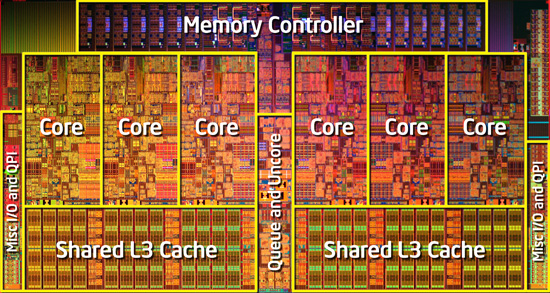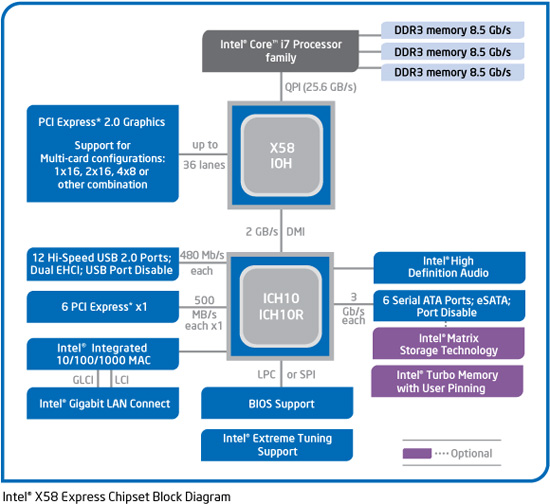The Core i7 980X Review: Intel's First 6-Core Desktop CPU
by Anand Lal Shimpi on March 11, 2010 12:00 AM EST- Posted in
- CPUs
A 12MB L3 Cache: 50% Larger, 14% Higher Latency
Gulftown sticks to Ronak’s 2MB of L3 per core rule and has a full, 12MB shared L3 cache that’s accessible by any or all of the six cores. It’s actually because of the large unified L3 cache that performance in applications that don’t use all six cores can be higher than quad-core Core i7s.

Nehalem

Gulftown
The added cache does come at the expense of higher access latency. Nehalem and Lynnfield had a 42-cycle 8MB L3, Gulftown has a 48 cycle 12MB L3. A 14% higher latency for a 50% increase in size. Not an insignificant penalty, but a tradeoff that makes sense.
Identical Power Consumption to the Core i7 975
Raja has been busy with his DC clamp meter measuring actual power consumption of CPUs themselves rather than measuring power consumption at the wall. The results below compare the actual power draw of the 32nm Core i7 980X to the 45nm Core i7 975. These values are just the CPU itself, the rest of the system is completely removed from the equation:
| CPU | Intel Core i7 980X | Intel Core i7 975 |
| Idle | 6.3W | 6.3W |
| Load | 136.8W | 133.2W |
Thanks to power gating, both of these chips idle at 6.3W. That's ridiculous for a 1.17B transistor chip. Under full load, the two are virtually identical - both drawing around 136W.
Westmere Goodness
The Core i7 980X is the first LGA-1366 processor based on Intel’s Westmere architecture, but unlike Clarkdale it does not have an on-die PCIe controller or on-package graphics. If anything, Gulftown really looks like a 6-core, 32nm version of Bloomfield rather than a scaled up Clarkdale. The similarities to Bloomfield extend all the way to the memory controller. Gulftown only officially supports three channels of DDR3-1066 memory, not 1333MHz like Lynnfield or Clarkdale. Of course running DDR3-1333 memory is possible, but the memory controller is technically operating out of spec at that frequency.

The processor does retain the Westmere specific features. The first Core i7 did not power gate its L3 cache, Lynnfield added it and Gulftown has it as well. While Mainly improved power efficiency and AES-NI instructions. I looked at the performance improvement offered by AES-NI acceleration in our Clarkdale review. If you use BitLocker or do a lot of archive encryption/decryption, you'll appreciate Gulftown's AES-NI.










102 Comments
View All Comments
aigomorla - Thursday, March 11, 2010 - link
W3680 will be a workstation hexcore @ 3.2ghzIm guessing since its a 3600 series, it will be a 1 x QPI, so it will not work in tandium on a DP board.
Xeons are uber expensive tho.
And this one if its gonna be priced like the W3580's is gonna have a price of around 1499.
:X
Rev1 - Thursday, March 11, 2010 - link
I know the OC's were on stock cooling but being this chip starts out @ 3.33 ghz and having a smaller 32nm size, the OC capability seems very underwhelming. I heard this chip is good for extreme overclockers because they did away with the cold boot bug. This thing probably puts out to much heat for any current air or wc setup to get a good oc out. That being said i dont see replacing my D0 920 anytime soon.aigomorla - Thursday, March 11, 2010 - link
come to our cpu and overclocking forum.http://forums.anandtech.com/showthread.php?t=20576...">http://forums.anandtech.com/showthread.php?t=20576...
Or read one of my comments with a forum link.
I showed people what it can do on higher voltages, when you take heat away from the equation of being the limited value.
Hacp - Thursday, March 11, 2010 - link
With the 800 dollar premium over an I7 920, why don't you just build a second 920 system instead!aigomorla - Thursday, March 11, 2010 - link
http://forums.anandtech.com/showthread.php?t=20450...">http://forums.anandtech.com/showthread.php?t=20450...;)
I welcome you guys to join our forums.
You'll see more info on stuff on the OC potentials in that preview.
atfuser - Thursday, March 11, 2010 - link
Looks like the i7-860 is where gamers and people who run lots of multicore apps want to spend their money. Gamers will save $750 and will see almost no difference in performance.RaistlinZ - Thursday, March 11, 2010 - link
Yes, gamers will still be more than satisfied with their i7 920's @ 4Ghz. Especially considering those chips are only $200 at Microcenter these days.I just hope the upcoming Xeon CPU's will have more of a mainstream price.
quickbunnie - Thursday, March 11, 2010 - link
I think the L4D performance is actually due to the extra cores, as source engine games have n-1 multithreaded scaling. It's been shown to have diminishing returns past 3-4 cores, so a 6% bump for an extra 2 cores makes more sense to me than the extra cache, considering no other games show this level of performance increasevailr - Thursday, March 11, 2010 - link
What happens if you put this 6 core CPU in a non-upgraded bios X58 board? Do you then have the minimal functionality to be able to flash the bios to the updated version? Or does the system fail completely, to even show anything on the video display?Just wondering...
aigomorla - Thursday, March 11, 2010 - link
If your bios can not handle gulftown, it will just refuse to post.eVGA boards are even more picky. If you somehow manage to get a hold of an A0 stepping gulftown, you can not use the same bios on a B0 or B1 gulftown.
The b0 and b1 are the retail versions, while the A series were pure evaluation / testing samples.
Some asus boards should support gulftown without bios updates, however its still recommended u get one.
And if u guys come into our forums, you will see i pushed one up to 4.4ghz with HT ON, @ 1.388 vcore, so i think my 980X is better then the one Raja has.
Sorry Raja.. :P